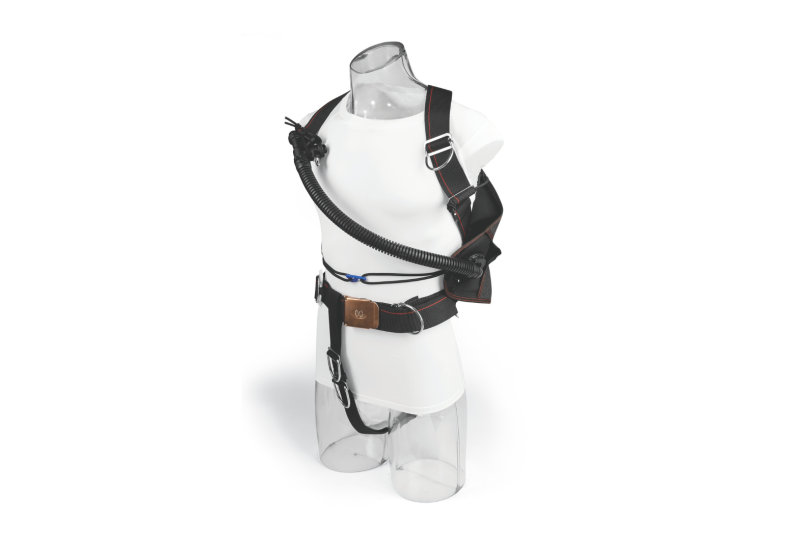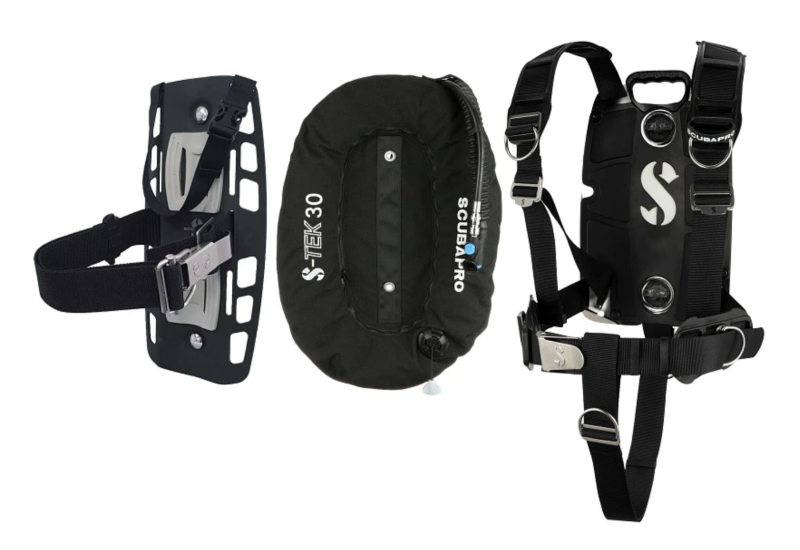15 Weight-Integrated Back-Buoyancy BCs
March 2002
By John Brumm
BCs Reviewed in This Article
| Aqua Lung Malibu RDS International Divers Advantage Mares Dragonfly AirTrim Mares Syncro Power Oceanic Chute 2 Oceanic Pro Tour Riptide Trek | SeaQuest Balance SeaQuest Black Diamond Scubapro Knighthawk Zeagle Concept II Pro Zeagle Escape 7105 VK & RK Zeagle Ranger Zeagle Scout |
You glide through the cobalt blue like a manta ray, bulky air bladder tucked behind your back. Up front, there's nothing but shoulder straps and a couple of contoured weight pouches. You're uncluttered, unencumbered and looking good. Welcome to the world of weight-integrated back buoyancy.
The 15 BCs reviewed here, submitted by eight manufacturers, represent the best in back-inflation buoyancy control. All of them earned above-average performance scores; any one of them would serve you well. However, some aspects of performance are clearly better on some BCs than on others. On the following pages we'll point out these differences.
The Testing
Each BC was unpacked, scrutinized and assembled. Owner's manuals were reviewed. BCs were tested for fit, then strapped to a tank. Valves were exercised, integrated weights dry-tested. All systems go, the BCs were hauled down to the water.
Over the past 10 years, as a result of 17 separate BC evaluations, Scuba Lab has established a test protocol in which specific subjective and objective criteria are applied to BCs in order to extract data based on a testing standard rather than on general impressions. Here's how it breaks down.
Subjective Evaluations
Assembly: Performed on deck without instructions. Although we believe all BCs should be supplied with clear and complete instructions, we also know that most divers will not take the instructions with them on a dive trip. So the question is: Are these intuitive systems, or, without owner's manuals, will we become lost in a jungle of straps and buckles?
Fit comfort and adjustment: Checked both in and out of the water. Adjustment was repeated during underwater tests.
Attitude and stability: Evaluated while swimming under water to determine if the BC would keep the diver in the proper swimming position without wobbling or tending to turn the diver over.
Access to attachments and pockets: Tested in and out of the water. All available methods of securing hoses were also tested.
Valve operation: Evaluated by the ease with which a diver could find and use the oral and power inflators, the oral deflate, the remote exhaust on the shoulder (if applicable) and the rear remote exhaust.
Ascent control: A measurement of how easily the BC could be used to control a normal ascent.
Weight system: Evaluated by the ease of loading and unloading, effect on attitude and stability, and ease of ditching.
Mechanical Evaluations
Flow rate of inflate and deflate valves: Scoring was based on the ability of the deflate valves to flow air faster than the power inflator.
Air trapping: A measurement of how much air was left in a BC's air cell after the deflate valves had been operated in the normal swimming position.
Inherent buoyancy: Measured with the BC empty.
Buoyant lift: The total lift capacity measured with the BC full. This was then compared to the manufacturer's rated lift capacities. Due to variations in how BCs are tested, the fact that BCs require a good deal of handwork to manufacture and that they are made of flexible material, a 10 percent variation between stated and measured lift capacities is considered reasonable, and up to a 20 percent variation is not unusual. But a variation greater than 20 percent means the manufacturer is not providing reasonably useful data for divers shopping for a BC.
Test Insights
-
Air trapping. All 15 BCs tested from "none" to "negligible" in this category. It was therefore not mentioned in the individual write-ups.
-
Pockets do not the BC make. In fact, some BCs don't even have them. So the question becomes: Can the mere lack of a pocket render a good BC bad? We don't think so. Consequently, we chose not to include pockets in the scoring sequence, preferring instead to address the subject in the individual write-ups.
-
Location, location, location. Some BCs have their rear lower remote exhaust valves on the left side of the air cell. For a diver who needs his or her left hand for handling the instrument console and operating the ambient hose inflator valve, this positioning is extremely awkward.
Pros & Cons of Back Buoyancy
Back buoyancy puts the bulk of your BC behind you. It clears your chest area, providing an unfettered fit. What's more, having your buoyancy in back tends to place you in the optimum underwater swimming position at depth (horizontal with head slightly higher than feet) and floats you higher out of the water when surface swimming on your back (considered the best surface swimming position). It also produces little to no body squeeze when fully inflated, and many manufacturers offer harnesses in different sizes and air cells with different lift capacities, enabling you to mix and match.
However, back buoyancy is not without its challenges. In particular, stability is more of an issue with back-buoyancy BCs than with jacket styles. At depth, successful back-buoyancy diving is all about weight distribution. Ballast and trim weights must be properly positioned and in the proper amounts to enable you to control your swimming attitude. Poorly positioned weights in your ditch pouches will cause you to constantly fight a tendency to roll onto your back. Too much weight, or weight placed too high, in your rear trim pouches and you're going to either want to roll when in the swimming position, or be pulled backward when in the vertical position.
On the surface, it's all about inflation control. With jacket-style BCs, you add air to your BC to increase surface stability. But do that with a back-buoyancy BC and you'll get slammed onto your face. On the surface, the best place for a back-buoyancy diver to be is on his back. However, if you find yourself struggling with your face in the water, resist the instinct to inflate your BC and instead deflate. Without the excessive buoyancy working against you, it will be easier to fin kick into a vertical position and regain control.
Ed's. note: For the purposes of this review, a "hard" backpack is defined as a molded, nonflexible, hard plastic design that supports the tank with the help of a single tank band. A "soft" backpack is defined as a flexible, foldable nonmolded design that usually gets some of its tank support through the use of an additional tank band.
Aqua Lung Malibu RDS: High Scores, Low Price
||
|---|
|

|
| Aqua Lung Malibu RDS|
Top performance scores combined with one of the lowest prices in this test group make Aqua Lung's Malibu RDS (rapid deployment weight system) both a Testers' Choice and a Best Buy. It's a stable and comfortable BC. A secondary Velcro strap positioned below the tank band helps eliminate tank wobble. A depth-compensating cummerbund works with molded shoulders that slip underneath the arms for a snug fit. The chest strap isn't positioned too high, and it's removable if necessary. There's also good padding along the back and lumbar region, although this probably contributes to the Malibu's inherent buoyancy.
The Malibu has no pockets, except for a small storage pouch located on the cummerbund. It's better than most cummerbund pouches because it's expandable, but access is difficult due to the cummerbund's overstrap. The inflator/deflator valve and rear remote exhaust produced some of the best air flow rates in this test group, but the pull dump deflator is slow.
The integrated weight system features contour pouches secured by a single Velcro flap. They load easily and ditch with a solid tug on the bright yellow plastic handles. Buckle clips secure the rear nonditchable trim weight pouches.
The Malibu offers six well-positioned stainless-steel D-rings and is twin-tank compatible. Measured buoyant lift fell within 10 percent of manufacturer's claims.
Price: $485.
Pockets with closures: 1 zippered.
Sizes: 5.
Buoyant lift (claimed): 30-40 lbs.
Weight system: Ditchable, 20 lbs. max.; nonditchable, 10 lbs. max.
Backpack: Hard.
Tank bands: 1+.
Pros: Excellent fit, comfort and adjustment. Easy assembly. Stability at depth. Good power inflator control. Excellent weight-load/ditch sytem.Excellent owner's manual.
Cons: Marked inherent buoyancy. Slow pull dump. Pocket difficult to access.
International Divers Advantage: Complex, but Comfortable
||
|---|
|

|
| International Divers Advantage|
IDI BCs are known for their complex and sometimes confusing straps, harnesses and multiple adjustments. The Advantage is no exception. But if you take the time to sort out the system, you can end up with a pretty comfortable fit, especially with IDI's Adjustable Torso-Rail system (for accommodating different torso lengths), depth-compensating cummerbund and crotch strap. An adjustable upper tank band and a pair of tank stabilizer straps minimize tank wobble and help pull the package together.
The bladder is wrapped in bungee to minimize "winging." Pockets are big and easy to get to, but they're set back over the hips, so they can be hard to see. There are eight stainless-steel D-rings for carrying extra gear along with a swiveled double clip for organizing hoses.
The integrated weight system uses roomy weight pouches that can be loaded easily while wearing the BC. But have your dive buddy look over the system before hitting the water. Loading the weight pouches requires fastening both a primary and a secondary Velcro strap. Overlook that second strap and your weights may not be secure. Plastic pull handles efficiently ditch weights.
Both the Advantage's inflate and deflate valves earned good scores for air flow, but the inflator valve fits awkwardly in the hand, which makes it difficult to use. Inherent buoyancy is minimal. Buoyant lift measured a variance less than 10 percent from manufacturer's claims.
Price: $550.
Pockets with closures: 2 Velcro, 1 zippered.
Sizes: 2.
Buoyant lift (claimed): 50 lbs.
Weight system: Ditchable, 20 lbs. max.; nonditchable, 10 lbs. max.
Backpack: Soft.
Tank bands: 2.
Pros: Good weight loading and ditching. Lots of lumbar padding. Good access to Velcro pockets. Good valve flow rates.
Cons: Difficult to assemble and adjust. Awkward power inflator. Minimal owner's manual.
Mares Dragonfly AirTrim: High-Tech Air Flow System
||
|---|
|

|
| Mares Dragonfly AirTrim|
A Testers' Choice, the Mares DragonFly AirTrim is a hybrid design with inflation beneath the arms to augment the primary rear air cell. Though it scored well in all categories, the DragonFly's air flow system is what really shines. Called AirTrim, it replaces the traditional ambient hose with a two-button control permanently attached to the BC. One button adds air, the other activates two pneumatic valves that simultaneously bleed air regardless of your swimming attitude.
This makes adjusting buoyancy extremely easy. The hand control is always in the same placea€"you never have to grope for an ambient hose. There's an oral inflator tucked in the right pocket in case of emergency. Two additional remote exhaust valves with pull cords dump air efficiently.
The DragonFly incorporates a traditional Velcro-flap weight system with easy-to-grip pull handles. Inside each drawstring weight pouch there's a slotted plastic board and strap. Hard weights are threaded onto the board, inserted into the pouch, then loaded into the BC (soft weights are tucked between the belt and the board). Weight pouches can be loaded while wearing the BC, but have your buddy check to make sure all flaps are properly secured.
The fold-out carrying handle is handy, and the molded backpack is contoured for perfect tank placement. Pocket access is good. The variance between claimed and measured buoyant lift exceeded 20 percent.
Price: $749.
Pockets with closures: 2 zippered.
Sizes: 5.
Buoyant lift (claimed): 27-47 lbs.
Weight system: Ditchable, 26 lbs. max.; nonditchable, 10 lbs. max.
Backpack: Hard.
Tank bands: 1.
Pros: Ease of assembly. Efficient weight-ditch system. Good access to pockets. Good valve flow rates, valve operation and ascent control with AirTrim system. Stability both at depth and on the surface. Negligible inherent buoyancy.
Cons: Considerable variance in rated buoyant lift. Minimal owner's manual.
Mares Syncro Power: Bulky and Buoyant
||
|---|
|

|
| Mares Syncro Power|
The Syncro Power uses the same Velcro weight system as the DragonFly, and is also equipped with multiple remote exhaust valves, but that's where the similarities end between these two Mares BCs. Sizes on the Syncro Power tend to be cut big, which creates a feeling of bulkiness. While stable at depth, tank wobble was nonetheless apparent. This BC has the highest inherent buoyancy (four pounds) of all BCs tested, with over 25 percent variance between the claimed and measured buoyant lift.
However, an ergonomic inflator valve allowed for efficient buoyancy control thanks to sensitive inflator and deflator buttons. The remote exhaust valves all dump air excellently, although the ambient hose pull dump is slow.
There's good access to the two large self-draining side pockets, but usable space is eaten up by the weight system. There are nine technopolymer D-rings for attaching extra gear and two swivel hose clips for positioning console and octopus. Padding along the back and lumbar region enhances comfort. There's an inflator valve cap attached to the ambient hose along with a two-tone DIN whistle, both nice touches.
Price: $399.
Pockets with closures: 2 zippered.
Sizes: 4.
Buoyant lift (claimed): 53 lbs.
Weight system: Ditchable, 26 lbs. max.; nonditchable, 10 lbs. max.
Backpack: Hard.
Tank bands: 1.
Pros: Assembly and adjustment. Fine-tunable valve for ascent control. Three remote exhaust valves. Good weight-ditch system.
Cons: Excessive inherent buoyancy. Substantial variance between claimed and measured buoyant lift. Slow pull dump. Confusing owner's manual.
Oceanic Chute 2: Good for Tech or Rec
||
|---|
|

|
| Oceanic Chute 2|
Substantial buoyant lift, a Kevlar-reinforced air cell and optional mounts for twin tanks make this Testers' Choice a logical choice for heavy rec or technical diving. Padding is thick along the back, especially in the lumbar region, and six heavy-duty stainless-steel D-rings will accommodate lots of additional gear.
Air flow rates on the Chute 2 are exceptional. Ergonomics are excellent on the inflator valve, allowing for minor buoyancy adjustments. When operated wide open, the inflator is on the slow side, but the deflate button is efficient and the pull dump and remote exhaust both dump air extremely fast.
Pockets are big and easy to access. The optional crotch strap is a good idea; without it, the BC tends to ride up in the inverted position. Measured buoyant lift came within 15 percent of manufacturer's claims.
The Chute 2's weight system uses a pair of large contoured weight pouches that slip into BC sleeves. Plastic tabs interlock, then a retaining pin is inserted to hold everything together. It's an effective mechanical system that allows for one-step ditching. But beware: The retaining pin must be inserted correctly or you risk the weight pouch falling out on its own. It's easy to do right, but just as easy to do wrong, especially when wearing the BC. Read the manual, and get your buddy to help.
Price: $609.95 plus $44.95 per pair of weight pouches.
Pockets with closures: 2 Velcro.
Sizes: 4.
Buoyant lift (claimed): 41-60 lbs.
Weight system: Ditchable, 32 lbs. max.; nonditchable, 10 lbs. max.
Backpack: Hard.
Tank bands: 1.
Pros: Ease of assembly. Comfortable fit. Stability at depth.Excellent valve flow rates. Good inflator action. Efficient weight-ditch system. Minimal inherent buoyancy. Excellent owner's manual.
Cons: Difficult to arm weight system while wearing BC.
Oceanic Pro Tour: Explosive Exhaust System
||
|---|
|

|
| Oceanic Pro Tour|
Oceanic's Pro Tour has the slowest inflate rates, and the fastest deflate rates, of all the BCs in this test go-round. The inflator valve fits very comfortably in the hand, allowing for fine-tuning.
The Pro Tour's Velcro flap weight pouches are positioned back on the hips at a 45-degree angle to the cummerbund. This takes the strain of the weight load off the Velcro flaps when in the swimming attitude. But it also makes ditching more difficult. Weight pouch handles are hard to reach, and then you have to pull and lift to free the weight pouches, which is awkward. Because weight pockets are set so far back, they affect stability at depth and are a pain to load when wearing the BC unless you first undo the cummerbund.
Otherwise, a depth-compensating cummerbund and padding along the back and lumbar regions make the Pro Tour a comfortable BC. The two storage pockets are side-loading, so it takes two hands to stuff and zip. Six stainless-steel D-rings and two hose clips are handy for organizing hoses and accommodating additional gear. Variance between claimed and measured buoyant lift: 10 percent.
Price: $639.95 plus $29.95 per pair of weight pouches.
Pockets with closures: 2 zippered.
Sizes: 4.
Buoyant lift (claimed): 40 lbs.
Weight system: Ditchable, 20 lbs. max.; nonditchable, 10 lbs. max.
Backpack: Soft.
Tank bands: 2.
Pros: Ease of assembly. Good fit, comfort and adjustment. Minimal inherent buoyancy. Excellent valve flow rates. Good valve operation and ascent control. Excellent owner's manual.
Cons: Pockets hard to access. Weights difficult to ditch. Weight pouch placement affects stability.
{mospagebreak}Riptide Trek: D-Rings Galore
||
|---|
|

|
| Riptide Trek|
A very nice-fitting BC, the Riptide Trek offers multiple adjustments to accommodate varying body shapes and lots of padding. There's a removable crotch strap, good for head-first descents. But the sternum strap is positioned too high, and in spite of depth-compensating elastic, the deflated bladder has a tendency to flap.
The inflator valve fits awkwardly in the hand, and the buttons are sticky, making it hard to fine-tune air flow. The pull-dump is also a bit stiff. But the ambient hose produced the best overhead deflation rates of all the BCs in this test group.
Designed for technical as well as rec diving, the Trek holds the record for stainless-steel D-rings (14) and is twin-tank compatible. It also has a scooter ring and slots to strap on a pony bottle. The double-band cylinder wrap system controls tank wobble. However, you can't readjust band tension without removing the BC from the tank. Unique to the Trek is a "Gear Bag" option that lets you convert from BC to backpack dive bag by unzipping the air cell and zipping on a mesh or solid gear bag. The Trek comes standard with a 50-pound-lift-capacity bladder; a 35-pound-lift-capacity bladder is available.
The Trek uses a vertical-load weight-ditch system. Pouches have zippered tops where you load weights and Velcro flap bottoms where weights dump. It's easy to load while wearing the BC, although the zipper, which seals rear to front, is difficult to close. (Note: The zipper is being redesigned to seal front to rear.)
Price: $599.
Pockets with closures: 1 Velcro, 1 zippered.
Sizes: 4.
Buoyant lift (claimed): 50 lbs.
Weight system: Ditchable, 24 lbs. max. lead weights, 20 lbs. soft weights; nonditchable, 20 lbs. max.
Backpack: Soft.
Tank bands: 2.
Pros: Good fit, comfort and adjustment. Good weight load/ditch system. Unique "Gear Bag" option.
Cons: Inflator valve awkward in hand. Marked inherent buoyancy. Slow pull dump. No owner's manual.
SeaQuest Balance
||
|---|
|

|
| SeaQuest Balance|
Simplicity is king with SeaQuest's Balance, a Testers' Choice. The air cell is low-profile. A depth-compensating waistband with big adjustment D-rings replaces the traditional cummerbund. Unique swivel buckles on the shoulder adjustments allow straps to wrap beneath the arms, clearing the chest area and optimizing fit. One large pocket folds beneath the right-side weight pouch, then drops for easy access when you want to use it. Its zipper closure can be operated with one hand.
The weight system is simple and effective. Weight pouches that contour to body shape load easily and are held in place by a single Velcro flap. They ditch with a simple tug on the plastic handles. Small buckle clips secure the rear trim weight pouches.
The inflator valve fits well in the hand and allows for minor adjustments to maintain buoyancy control. The Balance has minimal inherent buoyancy, and there is less than 10 percent variance between claimed and measured buoyant lift.
The Balance comes with one female release clip for attaching accessories and three pre-bent stainless-steel D-rings. The one D on the bottom edge of the BC is well-placed, but the two on the shoulders seem to be positioned too high.
Price: $510.
Pockets with closures: 1 zippered.
Sizes: 5.
Buoyant lift (claimed): 30-50 lbs.
Weight system: Ditchable, 20 lbs. max.; nonditchable, 10 lbs. max.
Backpack: Hard.
Tank bands: 1.
Pros: Ease of assembly. Versatile adjustment swivel system. Accessible pull-down pocket. Stable at depth. Good valve operation and ascent control. Excellent weight-ditch system. Excellent owner's manual.
Cons: No carrying handle. Minimal padding. Slow pull dump.
SeaQuest Black Diamond: Big Dog on the Block
||
|---|
|

|
| SeaQuest Black Diamond|
Designed with a large rigid backpack and substantial buoyant lift, capable of carrying lots of ballast and equipped with five heavy-duty stainless-steel D-rings for hauling everything but the kitchen sink, SeaQuest's Black Diamond, a clear Testers' Choice, is the Terminator of back-buoyancy BCs.
This top-scoring BC features swivel buckles on its pull-down straps and an adjustable chest strap. These, combined with ample padding, create a very comfortable, very snug fit. The BC doesn't ride up in the inverted position, even when not using the optional crotch strap.
The Black Diamond comes standard with SeaQuest's Powerline inflator; however, the test model was equipped with the optional Air Source, which combines inflator valve with second stage regulator. The Air Source produced good air flow rates, and the pull dump and dual remote exhaust valves provide efficient air dumping in both heads-up or fins-up positions.
Like the Balance, the Black Diamond utilizes a single-flap Velcro weight system with contoured weight pouches. But because of the BC's increased weight requirements, the pouches are twice the size. Still, pouches load and ditch efficiently.
The big Velcro pocket and zippered pull-down pocket are easy to get to. However, the zippered pouch on the cummerbund is difficult to access and doesn't hold much. The Black Diamond has minimal inherent buoyancy. The variance in measured buoyant lift versus manufacturer's claims is just over five percent.
Price: $660.
Pockets with closures: 2 zippered, 1 Velcro.
Sizes: 5.
Buoyant lift (claimed): 50 lbs.
Weight system: Ditchable, 32 lbs. max.; nonditchable, 10 lbs. max.
Backpack: Hard.
Tank bands: 1.
Pros: Ease of assembly. Excellent fit and adjustment. Big pockets. Stable at depth. Good ascent control. Excellent integrated weight system. Excellent owner's manual.
Cons: Bladder produces slight "winging" effect when deflated.
Scubapro Knighthawk: Super Stability
||
|---|
| 
" alt="" />|
| Scubapro Knighthawk|
Built tough for use in both recreational and technical diving, Scubapro's Knighthawk is an extremely stable BC. A contoured hard pack works with a single-strap stainless-steel cinch buckle to steady the tank. It's an effective and time-proven system; however, you can't adjust band tension without removing the BC from the tank.
The Knighthawk's mechanical weight system incorporates curved weight pouches with two-inch straps and quick-release buckles. It's extremely secure, but it requires two steps to ditch: first release the buckles, then pull out the weight pouches. Some test divers felt offering the quick-release buckles in high-visibility yellow would cut down on possible confusion when ditching weights in a panic situation. Scubapro offers "Ecoweights" to maximize the load capacity of its pouches, although tests showed that any type of weighta€"solid lead, vinyl-coated or shot poucha€"works well.
The inflator valve is streamlined, but still doesn't fit very well in the hand. The oral inflation mouthpiece is small. The inflate button action is blustery, making it difficult to fine-tune air flow. The pull dump performs adequately; the two remote exhaust valves dump air fast.
The Knighthawk comes with a molded carrying handle and padding along the back and lumbar region. The folding pocket is big, accessible and can be both deployed and secured with one hand. The other pocket is big enough for a small dive light. Variance between claimed and measured buoyant lift was five percent.
Price: $540 (with balanced power inflator).
Pockets with closures: 1 zippered.
Sizes: 4.
Buoyant lift (claimed): 34-46 lbs.
Weight system: Ditchable, 20 lbs. max.; nonditchable, 10 lbs. max.
Backpack: Hard.
Tank bands: 1.
Pros: Ease of assembly, and good comfort, fit and adjustment. Excellent stability at depth. Good ascent control. Minimal inherent buoyancy. Accurate buoyant lift figures. Good integrated weight security system.
Cons: Power inflator awkward to grip. Two-step weight-ditch system.
Zeagle Concept II Pro: "Ripcord" Weight Release
||
|---|
|

|
| Zeagle Concept II Pro|
The Concept Pro II, a Testers' Choice, is the beefy version of the Concept II series, with higher buoyant lift and more weight-carrying capacity. It's a modular BC: You select vest and shoulder components, then fit them to appropriate bladder sizes to get a BC customized to your individual diving needs. The result is a very comfortable BC with extra-wide shoulder straps, a depth-compensating cummerbund and substantial padding.
The Concept Pro II comes with Zeagle's patented "Ripcord" weight release system. The primary weight pouches are tied together with a threaded cord connected to a handle. With a single pull, all weights simultaneously ditch. It's by far the easiest method of ditching weights. The difficulty comes in re-threading the ripcord after the ditch. For that reason, it's better to use the zippered pouch openings to load and unload weights and use the Ripcord only for emergencies. Note: Avoid using small weights in this system. One, two and even three-pound soft weights can slip through the laced bottom of the ballast pockets.
Storage pockets are optional, but the Concept Pro II does come standard with double tank straps that control wobble and an elastic retractor system to rein in the air bladder. There are only four small plastic D-rings, and you can't access the rear remote exhaust valve without letting go of the ambient hose inflate/deflate valve. However, the inflator valve provides fine-tune adjustment and improves ascent control.
Price: $586.50.
Pockets with closures: None.
Sizes: Adjustable sizing.
Buoyant lift (claimed): 44 lbs.
Weight system: Ditchable, 40 lbs. front; 20 lbs. rear.
Backpack: Soft.
Tank bands: 2.
Pros: Ease of assembly. Good adjustment and fit. Efficient weight-ditch system. Good valve operation and ascent control. Negligible inherent buoyancy. Excellent weight ditching. Excellent owner's manual.
Cons: Slow pull dump. Difficult to re-arm weight system once activated. No pockets.
Zeagle Escape 7105 VK & RK: Good Performance, Good Price
||
|---|
|

|
| Zeagle Escape 7105 VK|
|

|
| Zeagle Escape 7105 RK|
Zeagle's Escape VK and RK, which are the same BC except for their weight systems and storage pockets, are both Best Buys thanks to good performance scores and a good price. The VK comes with conventional Velcro-flap weight pouches that load and ditch efficiently, and two Velcro storage pockets that are hard to access. The RK comes with the "Ripcord" weight-release system (see Concept Pro II), which ditches easily, and two zippered pockets that are hard to access and easy to confuse with the weight pouches.
Pockets and pouches aside, the Escape is a streamlined BC. It cinches up snug, leaving the chest area uncluttered. A depth-compensating cummerbund and thick lumbar padding provide comfort. The BC doesn't slip about, even in a heads-down position. A conventional band is used with a secondary upper strap to prevent tank wobble. The bladder is strung with an elastic retractor strap to control "winging."
In general, the Escape provides good inflation control; however, the pull dump doesn't seem able to keep up with the inflator on ascent (the ambient hose held overhead does). And the positioning of the rear remote exhaust on the lower left side is awkward.
Price: $479.
Pockets with closures: 2 Velcro (VK), 2 zippered (RK).
Sizes: Adjustable sizing.
Buoyant lift (claimed): 35 lbs.
Weight system: Ditchable, 20 lbs. front, 20 lbs. rear (VK); 30 pounds front, 20 pounds rear (RK).
Backpack: Soft.
Tank bands: 2.
Pros: Good assembly, fit and adjustment. Stable at depth. Good valve operation and ascent control. Good weight system (VK); excellent weight-ditch system (RK). Excellent owner's manual.
Cons: Slow pull dump. Storage pockets easily confused with weight pockets (RK). Difficult to re-arm weight system once activated (RK).
Zeagle Ranger: Rugged Recreational System
||
|---|
|

|
| Zeagle Ranger|
Marketed for divers who want "a rugged recreational system," the Zeagle Ranger is a heavy-duty, yet very comfortable BC that comes standard with a 44-pound-lift-capacity bladder. For those divers looking to get down to some serious business, there are 65-pound and larger lift capacity bladders available as options.
The Ranger is designed with adjustable elastic waist panels and a depth-compensating cummerbund for fit. Padding is minimal. A crotch strap is optional. Wing clips hold the air cell in closer for better streamlining at depth. Equipped with six stainless-steel D-rings, the two on the upper shoulders are adjustable. There are two zippered pockets that are easy to get to; problem is, they're positioned right on top of the weight pockets so it's easy to get them confused. The Ranger is twin-tank compatible.
The inflator valve fits comfortably in the hand and allows for fine-tuning buoyancy. The ambient hose held high produces very good deflation rates, but the pull dump is slow. Two rear remote exhaust valves dump air efficiently. Variance between claimed and measured buoyant lift is less than 15 percent.
The Ranger comes standard with Zeagle's patented "Ripcord" weight release system (see Concept Pro II). A removable Zipper Rear Mounted Weight System and a pull-out weight system like that used on the Escape VK are both available as options.
Price: $661.50.
Pockets with closures: 2 zippered, 1 Velcro.
Sizes: Adjustable sizing.
Buoyant lift (claimed): 44 lbs.
Weight system: Ditchable, 40 lbs. max., 20 lbs. rear (optional).
Backpack: Soft.
Tank bands: 2.
Pros: Ease of assembly. Good fit and adjustment. Stability at depth. Good valve operation, ascent control. Efficient weight-ditch system. Excellent owner's manual.
Cons: Slow pull dump. Marked inherent buoyancy. Storage pockets easily confused with weight pockets. Difficult to re-arm ditch system once activated.
Zeagle Scout: Unstable When Loaded
||
|---|
|

|
| Zeagle Scout|
The Scout is a simple, uncluttered weight-integrated BC with ballast pouches positioned alongside the tank (weights are ditched by reaching back and yanking on the lower flaps of the pouches). Available with either a 24- or 35-pound-lift air cell, the smaller cell is intended for smaller divers or warmer waters, while the larger cell is designed for divers who need to carry more ballast.
The problem is that the weight pockets are designed to hold up to 30 pounds positioned behind you. When they're loaded with more than a minimal amount of weight, the BC wants to turn you onto your back when in the swimming attitude, and flip you backwards when positioned heads-up. If you're going to use this BC in temperate waters, you'd be better off putting your ballast weight on a belt and using the weight pouches for trim only.
Otherwise, the Scout is a comfortable BC with a thick lumbar pad, wide shoulder straps and a waist strap instead of a cummerbund. The primary tank band and secondary tank strap are both vertically adjustable. The wings of the air cell have an elastic system to keep them from flopping about. Pockets are available as an option.
The inflator valve enables you to fine-tune your air flow, and the ambient hose dumps air well. But like other Zeagle BCs, the pull dump isn't very efficient and won't always keep ahead of the inflator in the wide-open position.
Price: $350.
Pockets with closures: None.
Sizes: Adjustable sizing.
Buoyant lift (claimed): 35 lbs.
Weight system: Ditchable, 30 lbs. max.
Backpack: Soft.
Tank bands: 2.
Pros: Ease of assembly, and good fit and adjustment. Negligible inherent buoyancy. Good valve control. Excellent owner's manual.
Cons: Weight-ditch tabs hard to reach. Unstable at depth.
March 2002
By John Brumm
BCs Reviewed in This Article
Aqua Lung Malibu RDS International Divers Advantage Mares Dragonfly AirTrim Mares Syncro Power Oceanic Chute 2 Oceanic Pro Tour Riptide TrekSea Quest Balance SeaQuest Black Diamond Scubapro Knighthawk Zeagle Concept II Pro Zeagle Escape 7105 VK & RK Zeagle Ranger Zeagle ScoutYou glide through the cobalt blue like a manta ray, bulky air bladder tucked behind your back. Up front, there's nothing but shoulder straps and a couple of contoured weight pouches. You're uncluttered, unencumbered and looking good. Welcome to the world of weight-integrated back buoyancy.
The 15 BCs reviewed here, submitted by eight manufacturers, represent the best in back-inflation buoyancy control. All of them earned above-average performance scores; any one of them would serve you well. However, some aspects of performance are clearly better on some BCs than on others. On the following pages we'll point out these differences.
The Testing
Each BC was unpacked, scrutinized and assembled. Owner's manuals were reviewed. BCs were tested for fit, then strapped to a tank. Valves were exercised, integrated weights dry-tested. All systems go, the BCs were hauled down to the water.
Over the past 10 years, as a result of 17 separate BC evaluations, Scuba Lab has established a test protocol in which specific subjective and objective criteria are applied to BCs in order to extract data based on a testing standard rather than on general impressions. Here's how it breaks down.
Subjective Evaluations
Assembly: Performed on deck without instructions. Although we believe all BCs should be supplied with clear and complete instructions, we also know that most divers will not take the instructions with them on a dive trip. So the question is: Are these intuitive systems, or, without owner's manuals, will we become lost in a jungle of straps and buckles?
Fit comfort and adjustment: Checked both in and out of the water. Adjustment was repeated during underwater tests.
Attitude and stability: Evaluated while swimming under water to determine if the BC would keep the diver in the proper swimming position without wobbling or tending to turn the diver over.
Access to attachments and pockets: Tested in and out of the water. All available methods of securing hoses were also tested.
Valve operation: Evaluated by the ease with which a diver could find and use the oral and power inflators, the oral deflate, the remote exhaust on the shoulder (if applicable) and the rear remote exhaust.
Ascent control: A measurement of how easily the BC could be used to control a normal ascent.
Weight system: Evaluated by the ease of loading and unloading, effect on attitude and stability, and ease of ditching.
Mechanical Evaluations
Flow rate of inflate and deflate valves: Scoring was based on the ability of the deflate valves to flow air faster than the power inflator.
Air trapping: A measurement of how much air was left in a BC's air cell after the deflate valves had been operated in the normal swimming position.
Inherent buoyancy: Measured with the BC empty.
Buoyant lift: The total lift capacity measured with the BC full. This was then compared to the manufacturer's rated lift capacities. Due to variations in how BCs are tested, the fact that BCs require a good deal of handwork to manufacture and that they are made of flexible material, a 10 percent variation between stated and measured lift capacities is considered reasonable, and up to a 20 percent variation is not unusual. But a variation greater than 20 percent means the manufacturer is not providing reasonably useful data for divers shopping for a BC.
Test Insights
Air trapping. All 15 BCs tested from "none" to "negligible" in this category. It was therefore not mentioned in the individual write-ups.
Pockets do not the BC make. In fact, some BCs don't even have them. So the question becomes: Can the mere lack of a pocket render a good BC bad? We don't think so. Consequently, we chose not to include pockets in the scoring sequence, preferring instead to address the subject in the individual write-ups.
Location, location, location. Some BCs have their rear lower remote exhaust valves on the left side of the air cell. For a diver who needs his or her left hand for handling the instrument console and operating the ambient hose inflator valve, this positioning is extremely awkward.
Pros & Cons of Back Buoyancy
Back buoyancy puts the bulk of your BC behind you. It clears your chest area, providing an unfettered fit. What's more, having your buoyancy in back tends to place you in the optimum underwater swimming position at depth (horizontal with head slightly higher than feet) and floats you higher out of the water when surface swimming on your back (considered the best surface swimming position). It also produces little to no body squeeze when fully inflated, and many manufacturers offer harnesses in different sizes and air cells with different lift capacities, enabling you to mix and match.
However, back buoyancy is not without its challenges. In particular, stability is more of an issue with back-buoyancy BCs than with jacket styles. At depth, successful back-buoyancy diving is all about weight distribution. Ballast and trim weights must be properly positioned and in the proper amounts to enable you to control your swimming attitude. Poorly positioned weights in your ditch pouches will cause you to constantly fight a tendency to roll onto your back. Too much weight, or weight placed too high, in your rear trim pouches and you're going to either want to roll when in the swimming position, or be pulled backward when in the vertical position.
On the surface, it's all about inflation control. With jacket-style BCs, you add air to your BC to increase surface stability. But do that with a back-buoyancy BC and you'll get slammed onto your face. On the surface, the best place for a back-buoyancy diver to be is on his back. However, if you find yourself struggling with your face in the water, resist the instinct to inflate your BC and instead deflate. Without the excessive buoyancy working against you, it will be easier to fin kick into a vertical position and regain control.
Ed's. note: For the purposes of this review, a "hard" backpack is defined as a molded, nonflexible, hard plastic design that supports the tank with the help of a single tank band. A "soft" backpack is defined as a flexible, foldable nonmolded design that usually gets some of its tank support through the use of an additional tank band.
Aqua Lung Malibu RDS: High Scores, Low Price

| | Aqua Lung Malibu RDS| Top performance scores combined with one of the lowest prices in this test group make Aqua Lung's Malibu RDS (rapid deployment weight system) both a Testers' Choice and a Best Buy. It's a stable and comfortable BC. A secondary Velcro strap positioned below the tank band helps eliminate tank wobble. A depth-compensating cummerbund works with molded shoulders that slip underneath the arms for a snug fit. The chest strap isn't positioned too high, and it's removable if necessary. There's also good padding along the back and lumbar region, although this probably contributes to the Malibu's inherent buoyancy.
The Malibu has no pockets, except for a small storage pouch located on the cummerbund. It's better than most cummerbund pouches because it's expandable, but access is difficult due to the cummerbund's overstrap. The inflator/deflator valve and rear remote exhaust produced some of the best air flow rates in this test group, but the pull dump deflator is slow.
The integrated weight system features contour pouches secured by a single Velcro flap. They load easily and ditch with a solid tug on the bright yellow plastic handles. Buckle clips secure the rear nonditchable trim weight pouches.
The Malibu offers six well-positioned stainless-steel D-rings and is twin-tank compatible. Measured buoyant lift fell within 10 percent of manufacturer's claims.
Price: $485.
Pockets with closures: 1 zippered.
Sizes: 5.
Buoyant lift (claimed): 30-40 lbs.
Weight system: Ditchable, 20 lbs. max.; nonditchable, 10 lbs. max.
Backpack: Hard.
Tank bands: 1+.
Pros: Excellent fit, comfort and adjustment. Easy assembly. Stability at depth. Good power inflator control. Excellent weight-load/ditch sytem.Excellent owner's manual.
Cons: Marked inherent buoyancy. Slow pull dump. Pocket difficult to access.
International Divers Advantage: Complex, but Comfortable
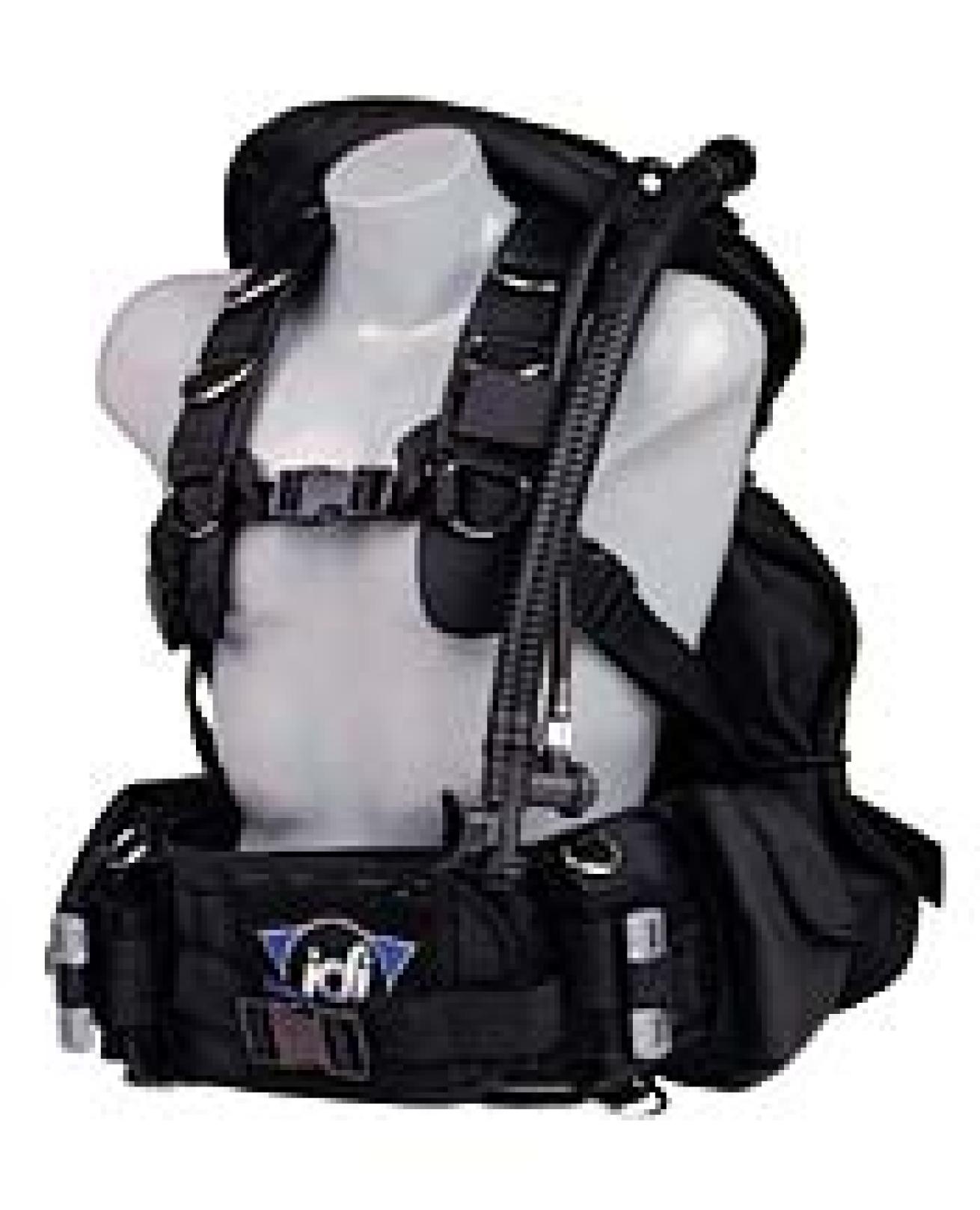
| | International Divers Advantage| IDI BCs are known for their complex and sometimes confusing straps, harnesses and multiple adjustments. The Advantage is no exception. But if you take the time to sort out the system, you can end up with a pretty comfortable fit, especially with IDI's Adjustable Torso-Rail system (for accommodating different torso lengths), depth-compensating cummerbund and crotch strap. An adjustable upper tank band and a pair of tank stabilizer straps minimize tank wobble and help pull the package together.
The bladder is wrapped in bungee to minimize "winging." Pockets are big and easy to get to, but they're set back over the hips, so they can be hard to see. There are eight stainless-steel D-rings for carrying extra gear along with a swiveled double clip for organizing hoses.
The integrated weight system uses roomy weight pouches that can be loaded easily while wearing the BC. But have your dive buddy look over the system before hitting the water. Loading the weight pouches requires fastening both a primary and a secondary Velcro strap. Overlook that second strap and your weights may not be secure. Plastic pull handles efficiently ditch weights.
Both the Advantage's inflate and deflate valves earned good scores for air flow, but the inflator valve fits awkwardly in the hand, which makes it difficult to use. Inherent buoyancy is minimal. Buoyant lift measured a variance less than 10 percent from manufacturer's claims.
Price: $550.
Pockets with closures: 2 Velcro, 1 zippered.
Sizes: 2.
Buoyant lift (claimed): 50 lbs.
Weight system: Ditchable, 20 lbs. max.; nonditchable, 10 lbs. max.
Backpack: Soft.
Tank bands: 2.
Pros: Good weight loading and ditching. Lots of lumbar padding. Good access to Velcro pockets. Good valve flow rates.
Cons: Difficult to assemble and adjust. Awkward power inflator. Minimal owner's manual.
Mares Dragonfly AirTrim: High-Tech Air Flow System
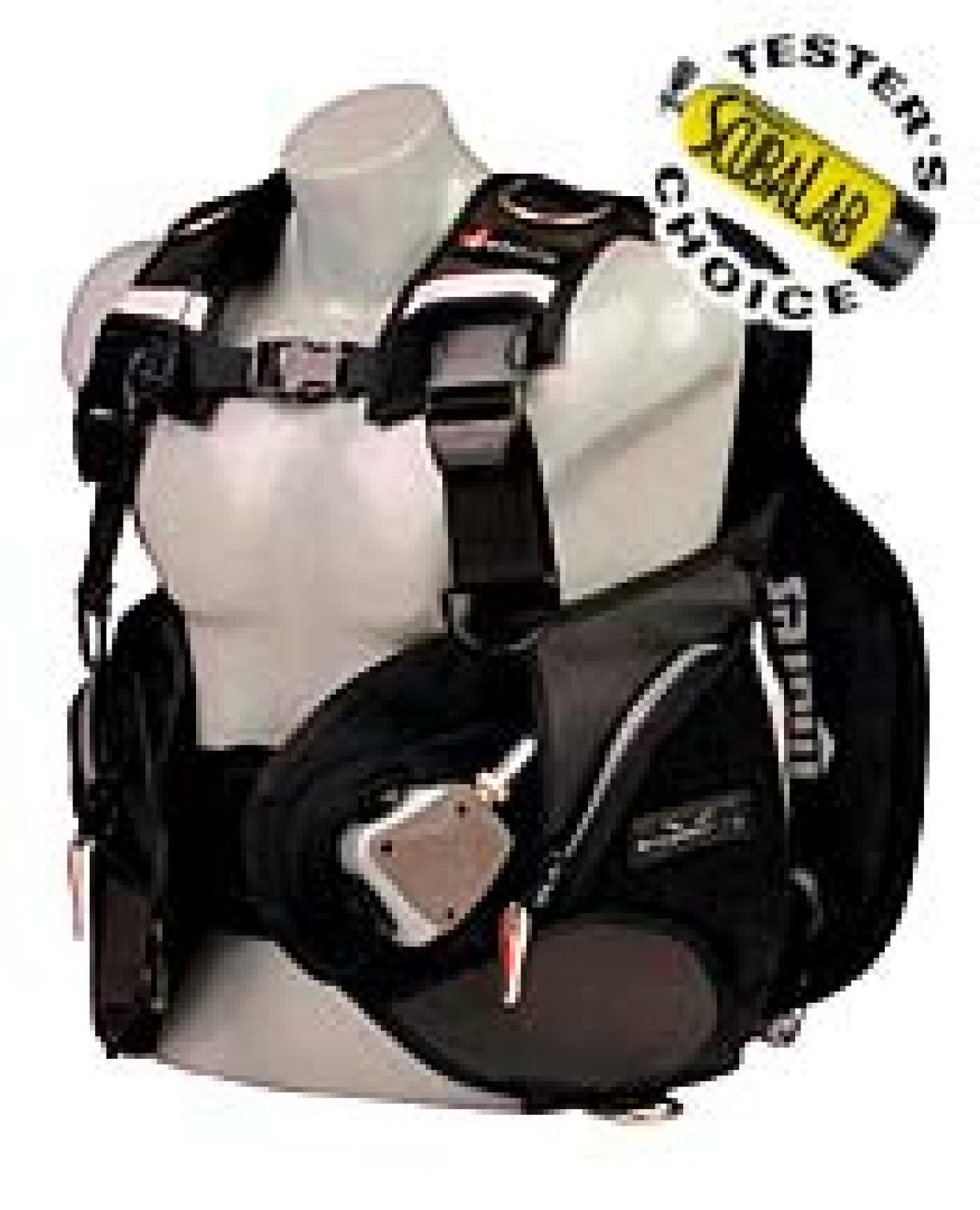
| | Mares Dragonfly AirTrim| A Testers' Choice, the Mares DragonFly AirTrim is a hybrid design with inflation beneath the arms to augment the primary rear air cell. Though it scored well in all categories, the DragonFly's air flow system is what really shines. Called AirTrim, it replaces the traditional ambient hose with a two-button control permanently attached to the BC. One button adds air, the other activates two pneumatic valves that simultaneously bleed air regardless of your swimming attitude.
This makes adjusting buoyancy extremely easy. The hand control is always in the same placea€"you never have to grope for an ambient hose. There's an oral inflator tucked in the right pocket in case of emergency. Two additional remote exhaust valves with pull cords dump air efficiently.
The DragonFly incorporates a traditional Velcro-flap weight system with easy-to-grip pull handles. Inside each drawstring weight pouch there's a slotted plastic board and strap. Hard weights are threaded onto the board, inserted into the pouch, then loaded into the BC (soft weights are tucked between the belt and the board). Weight pouches can be loaded while wearing the BC, but have your buddy check to make sure all flaps are properly secured.
The fold-out carrying handle is handy, and the molded backpack is contoured for perfect tank placement. Pocket access is good. The variance between claimed and measured buoyant lift exceeded 20 percent.
Price: $749.
Pockets with closures: 2 zippered.
Sizes: 5.
Buoyant lift (claimed): 27-47 lbs.
Weight system: Ditchable, 26 lbs. max.; nonditchable, 10 lbs. max.
Backpack: Hard.
Tank bands: 1.
Pros: Ease of assembly. Efficient weight-ditch system. Good access to pockets. Good valve flow rates, valve operation and ascent control with AirTrim system. Stability both at depth and on the surface. Negligible inherent buoyancy.
Cons: Considerable variance in rated buoyant lift. Minimal owner's manual.
Mares Syncro Power: Bulky and Buoyant
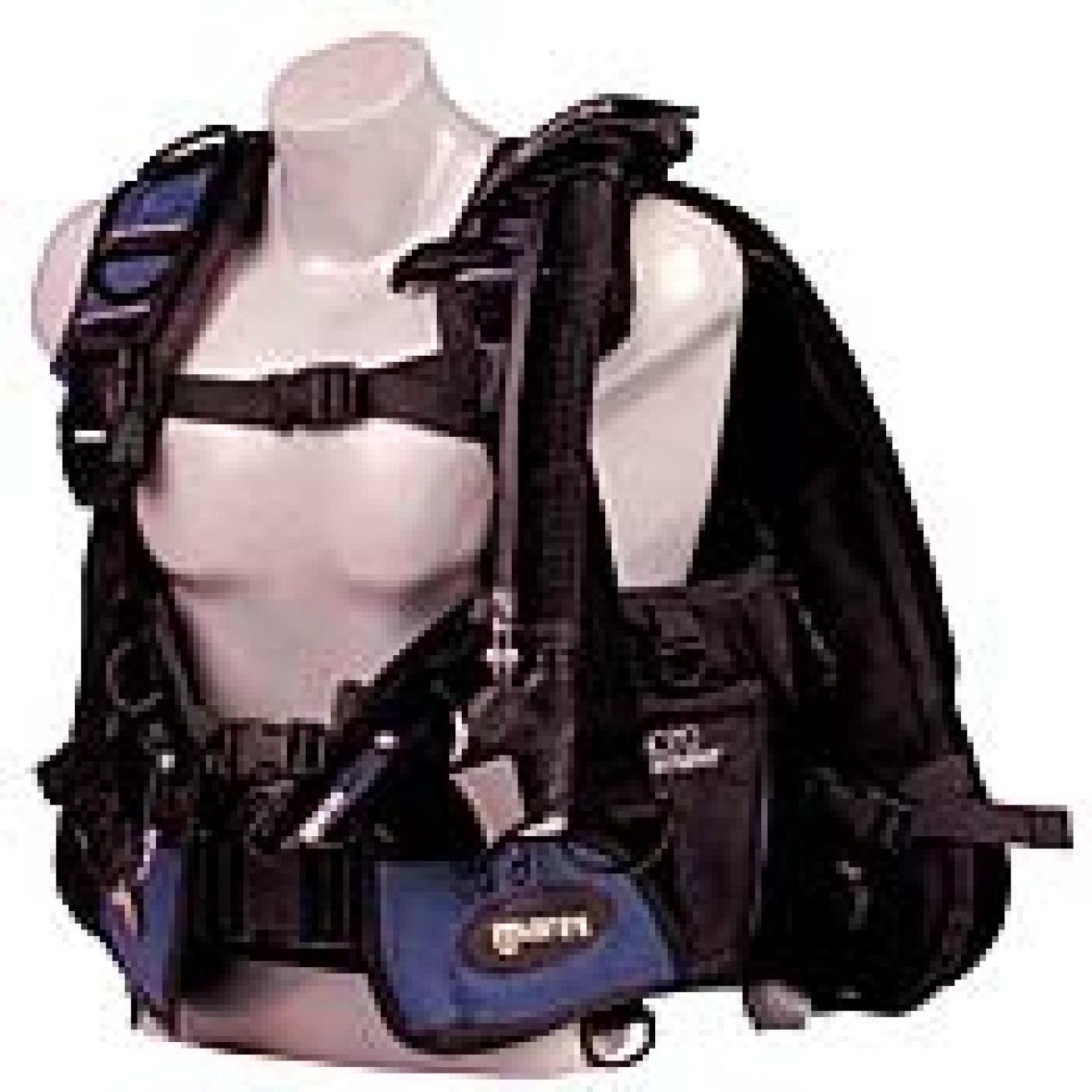
| | Mares Syncro Power| The Syncro Power uses the same Velcro weight system as the DragonFly, and is also equipped with multiple remote exhaust valves, but that's where the similarities end between these two Mares BCs. Sizes on the Syncro Power tend to be cut big, which creates a feeling of bulkiness. While stable at depth, tank wobble was nonetheless apparent. This BC has the highest inherent buoyancy (four pounds) of all BCs tested, with over 25 percent variance between the claimed and measured buoyant lift.
However, an ergonomic inflator valve allowed for efficient buoyancy control thanks to sensitive inflator and deflator buttons. The remote exhaust valves all dump air excellently, although the ambient hose pull dump is slow.
There's good access to the two large self-draining side pockets, but usable space is eaten up by the weight system. There are nine technopolymer D-rings for attaching extra gear and two swivel hose clips for positioning console and octopus. Padding along the back and lumbar region enhances comfort. There's an inflator valve cap attached to the ambient hose along with a two-tone DIN whistle, both nice touches.
Price: $399.
Pockets with closures: 2 zippered.
Sizes: 4.
Buoyant lift (claimed): 53 lbs.
Weight system: Ditchable, 26 lbs. max.; nonditchable, 10 lbs. max.
Backpack: Hard.
Tank bands: 1.
Pros: Assembly and adjustment. Fine-tunable valve for ascent control. Three remote exhaust valves. Good weight-ditch system.
Cons: Excessive inherent buoyancy. Substantial variance between claimed and measured buoyant lift. Slow pull dump. Confusing owner's manual.
Oceanic Chute 2: Good for Tech or Rec
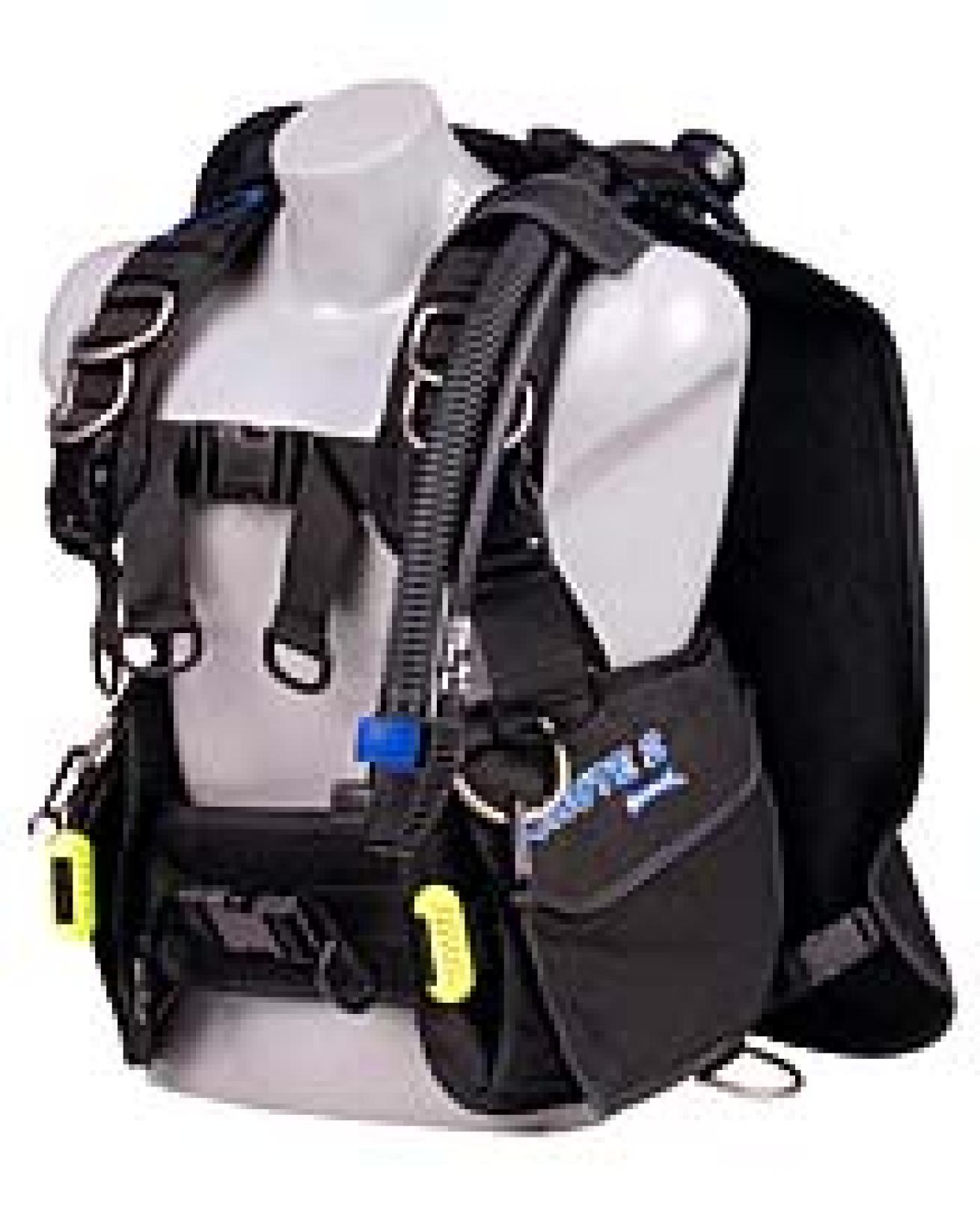
| | Oceanic Chute 2| Substantial buoyant lift, a Kevlar-reinforced air cell and optional mounts for twin tanks make this Testers' Choice a logical choice for heavy rec or technical diving. Padding is thick along the back, especially in the lumbar region, and six heavy-duty stainless-steel D-rings will accommodate lots of additional gear.
Air flow rates on the Chute 2 are exceptional. Ergonomics are excellent on the inflator valve, allowing for minor buoyancy adjustments. When operated wide open, the inflator is on the slow side, but the deflate button is efficient and the pull dump and remote exhaust both dump air extremely fast.
Pockets are big and easy to access. The optional crotch strap is a good idea; without it, the BC tends to ride up in the inverted position. Measured buoyant lift came within 15 percent of manufacturer's claims.
The Chute 2's weight system uses a pair of large contoured weight pouches that slip into BC sleeves. Plastic tabs interlock, then a retaining pin is inserted to hold everything together. It's an effective mechanical system that allows for one-step ditching. But beware: The retaining pin must be inserted correctly or you risk the weight pouch falling out on its own. It's easy to do right, but just as easy to do wrong, especially when wearing the BC. Read the manual, and get your buddy to help.
Price: $609.95 plus $44.95 per pair of weight pouches.
Pockets with closures: 2 Velcro.
Sizes: 4.
Buoyant lift (claimed): 41-60 lbs.
Weight system: Ditchable, 32 lbs. max.; nonditchable, 10 lbs. max.
Backpack: Hard.
Tank bands: 1.
Pros: Ease of assembly. Comfortable fit. Stability at depth.Excellent valve flow rates. Good inflator action. Efficient weight-ditch system. Minimal inherent buoyancy. Excellent owner's manual.
Cons: Difficult to arm weight system while wearing BC.
Oceanic Pro Tour: Explosive Exhaust System
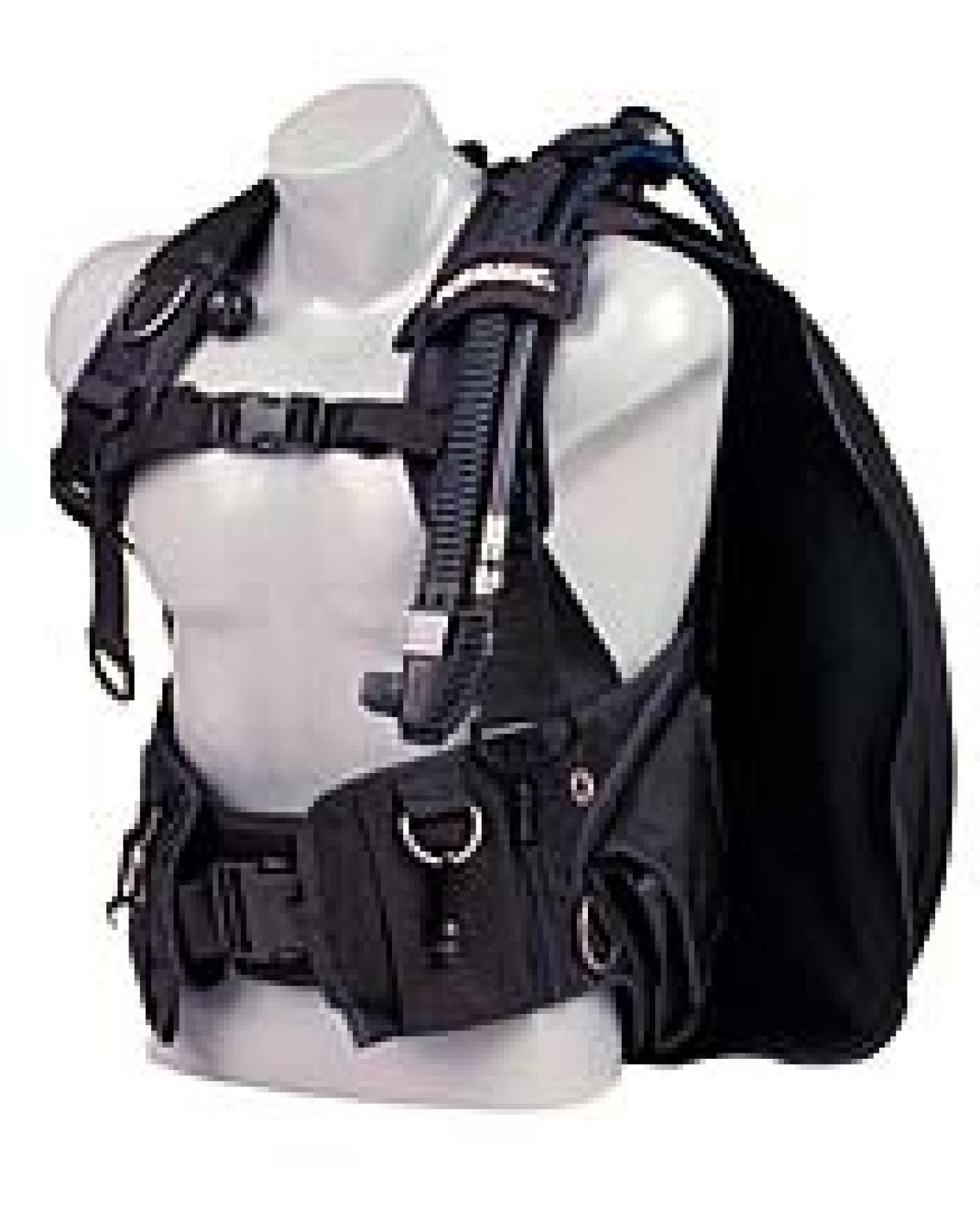
| | Oceanic Pro Tour| Oceanic's Pro Tour has the slowest inflate rates, and the fastest deflate rates, of all the BCs in this test go-round. The inflator valve fits very comfortably in the hand, allowing for fine-tuning.
The Pro Tour's Velcro flap weight pouches are positioned back on the hips at a 45-degree angle to the cummerbund. This takes the strain of the weight load off the Velcro flaps when in the swimming attitude. But it also makes ditching more difficult. Weight pouch handles are hard to reach, and then you have to pull and lift to free the weight pouches, which is awkward. Because weight pockets are set so far back, they affect stability at depth and are a pain to load when wearing the BC unless you first undo the cummerbund.
Otherwise, a depth-compensating cummerbund and padding along the back and lumbar regions make the Pro Tour a comfortable BC. The two storage pockets are side-loading, so it takes two hands to stuff and zip. Six stainless-steel D-rings and two hose clips are handy for organizing hoses and accommodating additional gear. Variance between claimed and measured buoyant lift: 10 percent.
Price: $639.95 plus $29.95 per pair of weight pouches.
Pockets with closures: 2 zippered.
Sizes: 4.
Buoyant lift (claimed): 40 lbs.
Weight system: Ditchable, 20 lbs. max.; nonditchable, 10 lbs. max.
Backpack: Soft.
Tank bands: 2.
Pros: Ease of assembly. Good fit, comfort and adjustment. Minimal inherent buoyancy. Excellent valve flow rates. Good valve operation and ascent control. Excellent owner's manual.
Cons: Pockets hard to access. Weights difficult to ditch. Weight pouch placement affects stability.
{mospagebreak}Riptide Trek: D-Rings Galore

| | Riptide Trek| A very nice-fitting BC, the Riptide Trek offers multiple adjustments to accommodate varying body shapes and lots of padding. There's a removable crotch strap, good for head-first descents. But the sternum strap is positioned too high, and in spite of depth-compensating elastic, the deflated bladder has a tendency to flap.
The inflator valve fits awkwardly in the hand, and the buttons are sticky, making it hard to fine-tune air flow. The pull-dump is also a bit stiff. But the ambient hose produced the best overhead deflation rates of all the BCs in this test group.
Designed for technical as well as rec diving, the Trek holds the record for stainless-steel D-rings (14) and is twin-tank compatible. It also has a scooter ring and slots to strap on a pony bottle. The double-band cylinder wrap system controls tank wobble. However, you can't readjust band tension without removing the BC from the tank. Unique to the Trek is a "Gear Bag" option that lets you convert from BC to backpack dive bag by unzipping the air cell and zipping on a mesh or solid gear bag. The Trek comes standard with a 50-pound-lift-capacity bladder; a 35-pound-lift-capacity bladder is available.
The Trek uses a vertical-load weight-ditch system. Pouches have zippered tops where you load weights and Velcro flap bottoms where weights dump. It's easy to load while wearing the BC, although the zipper, which seals rear to front, is difficult to close. (Note: The zipper is being redesigned to seal front to rear.)
Price: $599.
Pockets with closures: 1 Velcro, 1 zippered.
Sizes: 4.
Buoyant lift (claimed): 50 lbs.
Weight system: Ditchable, 24 lbs. max. lead weights, 20 lbs. soft weights; nonditchable, 20 lbs. max.
Backpack: Soft.
Tank bands: 2.
Pros: Good fit, comfort and adjustment. Good weight load/ditch system. Unique "Gear Bag" option.
Cons: Inflator valve awkward in hand. Marked inherent buoyancy. Slow pull dump. No owner's manual.
SeaQuest Balance
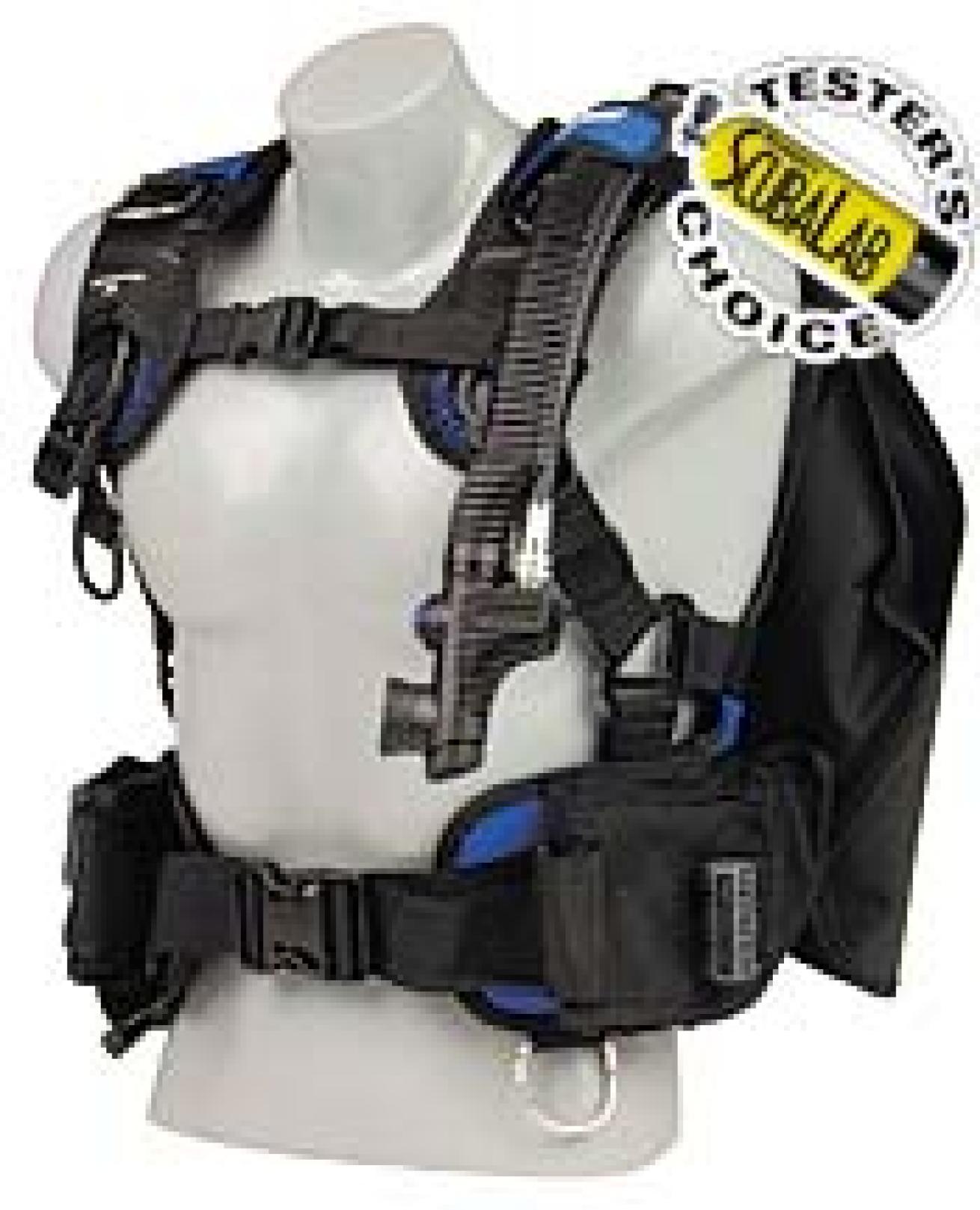
| | SeaQuest Balance| Simplicity is king with SeaQuest's Balance, a Testers' Choice. The air cell is low-profile. A depth-compensating waistband with big adjustment D-rings replaces the traditional cummerbund. Unique swivel buckles on the shoulder adjustments allow straps to wrap beneath the arms, clearing the chest area and optimizing fit. One large pocket folds beneath the right-side weight pouch, then drops for easy access when you want to use it. Its zipper closure can be operated with one hand.
The weight system is simple and effective. Weight pouches that contour to body shape load easily and are held in place by a single Velcro flap. They ditch with a simple tug on the plastic handles. Small buckle clips secure the rear trim weight pouches.
The inflator valve fits well in the hand and allows for minor adjustments to maintain buoyancy control. The Balance has minimal inherent buoyancy, and there is less than 10 percent variance between claimed and measured buoyant lift.
The Balance comes with one female release clip for attaching accessories and three pre-bent stainless-steel D-rings. The one D on the bottom edge of the BC is well-placed, but the two on the shoulders seem to be positioned too high.
Price: $510.
Pockets with closures: 1 zippered.
Sizes: 5.
Buoyant lift (claimed): 30-50 lbs.
Weight system: Ditchable, 20 lbs. max.; nonditchable, 10 lbs. max.
Backpack: Hard.
Tank bands: 1.
Pros: Ease of assembly. Versatile adjustment swivel system. Accessible pull-down pocket. Stable at depth. Good valve operation and ascent control. Excellent weight-ditch system. Excellent owner's manual.
Cons: No carrying handle. Minimal padding. Slow pull dump.
SeaQuest Black Diamond: Big Dog on the Block
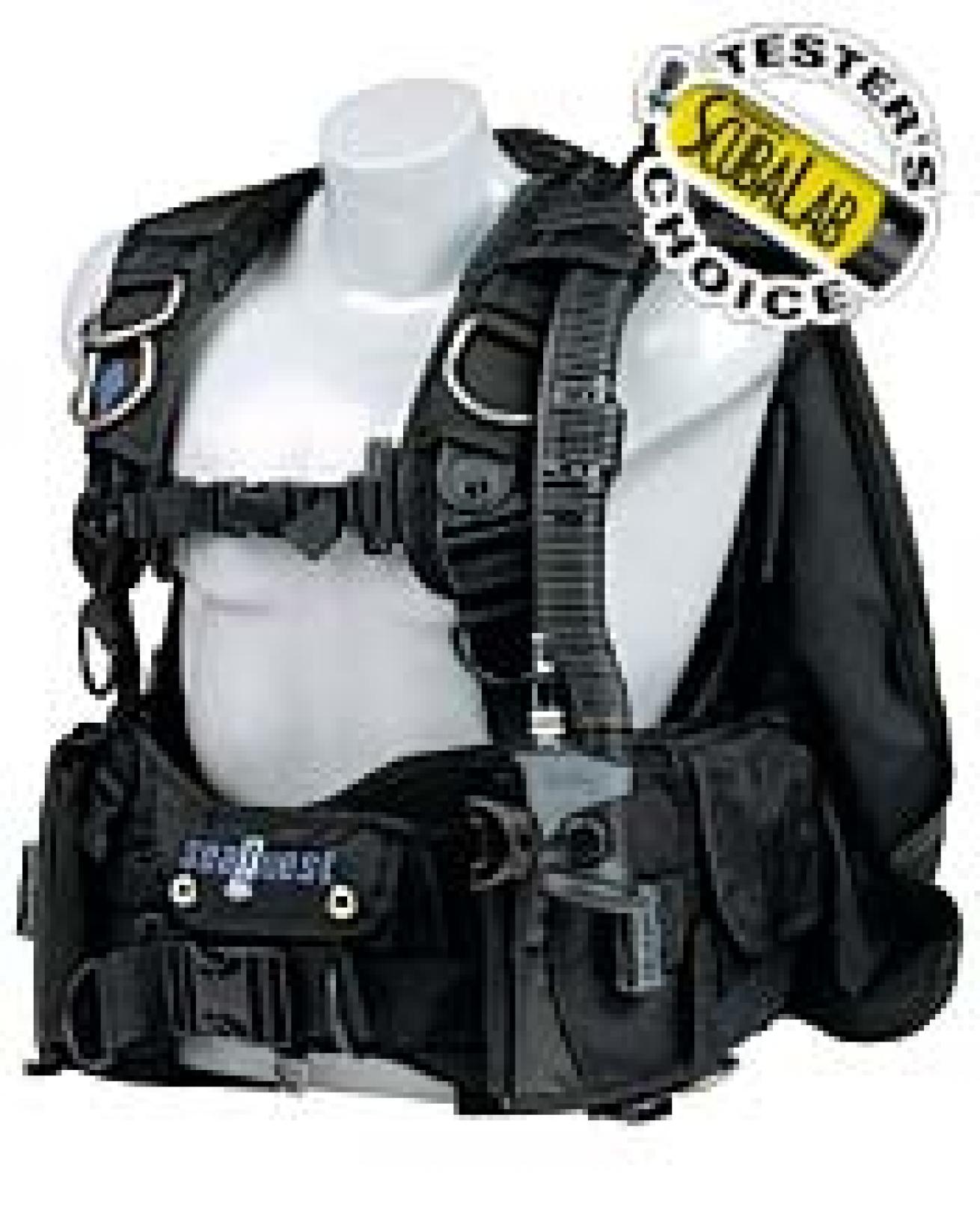
| | SeaQuest Black Diamond| Designed with a large rigid backpack and substantial buoyant lift, capable of carrying lots of ballast and equipped with five heavy-duty stainless-steel D-rings for hauling everything but the kitchen sink, SeaQuest's Black Diamond, a clear Testers' Choice, is the Terminator of back-buoyancy BCs.
This top-scoring BC features swivel buckles on its pull-down straps and an adjustable chest strap. These, combined with ample padding, create a very comfortable, very snug fit. The BC doesn't ride up in the inverted position, even when not using the optional crotch strap.
The Black Diamond comes standard with SeaQuest's Powerline inflator; however, the test model was equipped with the optional Air Source, which combines inflator valve with second stage regulator. The Air Source produced good air flow rates, and the pull dump and dual remote exhaust valves provide efficient air dumping in both heads-up or fins-up positions.
Like the Balance, the Black Diamond utilizes a single-flap Velcro weight system with contoured weight pouches. But because of the BC's increased weight requirements, the pouches are twice the size. Still, pouches load and ditch efficiently.
The big Velcro pocket and zippered pull-down pocket are easy to get to. However, the zippered pouch on the cummerbund is difficult to access and doesn't hold much. The Black Diamond has minimal inherent buoyancy. The variance in measured buoyant lift versus manufacturer's claims is just over five percent.
Price: $660.
Pockets with closures: 2 zippered, 1 Velcro.
Sizes: 5.
Buoyant lift (claimed): 50 lbs.
Weight system: Ditchable, 32 lbs. max.; nonditchable, 10 lbs. max.
Backpack: Hard.
Tank bands: 1.
Pros: Ease of assembly. Excellent fit and adjustment. Big pockets. Stable at depth. Good ascent control. Excellent integrated weight system. Excellent owner's manual.
Cons: Bladder produces slight "winging" effect when deflated.
Scubapro Knighthawk: Super Stability

)| | Scubapro Knighthawk| Built tough for use in both recreational and technical diving, Scubapro's Knighthawk is an extremely stable BC. A contoured hard pack works with a single-strap stainless-steel cinch buckle to steady the tank. It's an effective and time-proven system; however, you can't adjust band tension without removing the BC from the tank.
The Knighthawk's mechanical weight system incorporates curved weight pouches with two-inch straps and quick-release buckles. It's extremely secure, but it requires two steps to ditch: first release the buckles, then pull out the weight pouches. Some test divers felt offering the quick-release buckles in high-visibility yellow would cut down on possible confusion when ditching weights in a panic situation. Scubapro offers "Ecoweights" to maximize the load capacity of its pouches, although tests showed that any type of weighta€"solid lead, vinyl-coated or shot poucha€"works well.
The inflator valve is streamlined, but still doesn't fit very well in the hand. The oral inflation mouthpiece is small. The inflate button action is blustery, making it difficult to fine-tune air flow. The pull dump performs adequately; the two remote exhaust valves dump air fast.
The Knighthawk comes with a molded carrying handle and padding along the back and lumbar region. The folding pocket is big, accessible and can be both deployed and secured with one hand. The other pocket is big enough for a small dive light. Variance between claimed and measured buoyant lift was five percent.
Price: $540 (with balanced power inflator).
Pockets with closures: 1 zippered.
Sizes: 4.
Buoyant lift (claimed): 34-46 lbs.
Weight system: Ditchable, 20 lbs. max.; nonditchable, 10 lbs. max.
Backpack: Hard.
Tank bands: 1.
Pros: Ease of assembly, and good comfort, fit and adjustment. Excellent stability at depth. Good ascent control. Minimal inherent buoyancy. Accurate buoyant lift figures. Good integrated weight security system.
Cons: Power inflator awkward to grip. Two-step weight-ditch system.
Zeagle Concept II Pro: "Ripcord" Weight Release
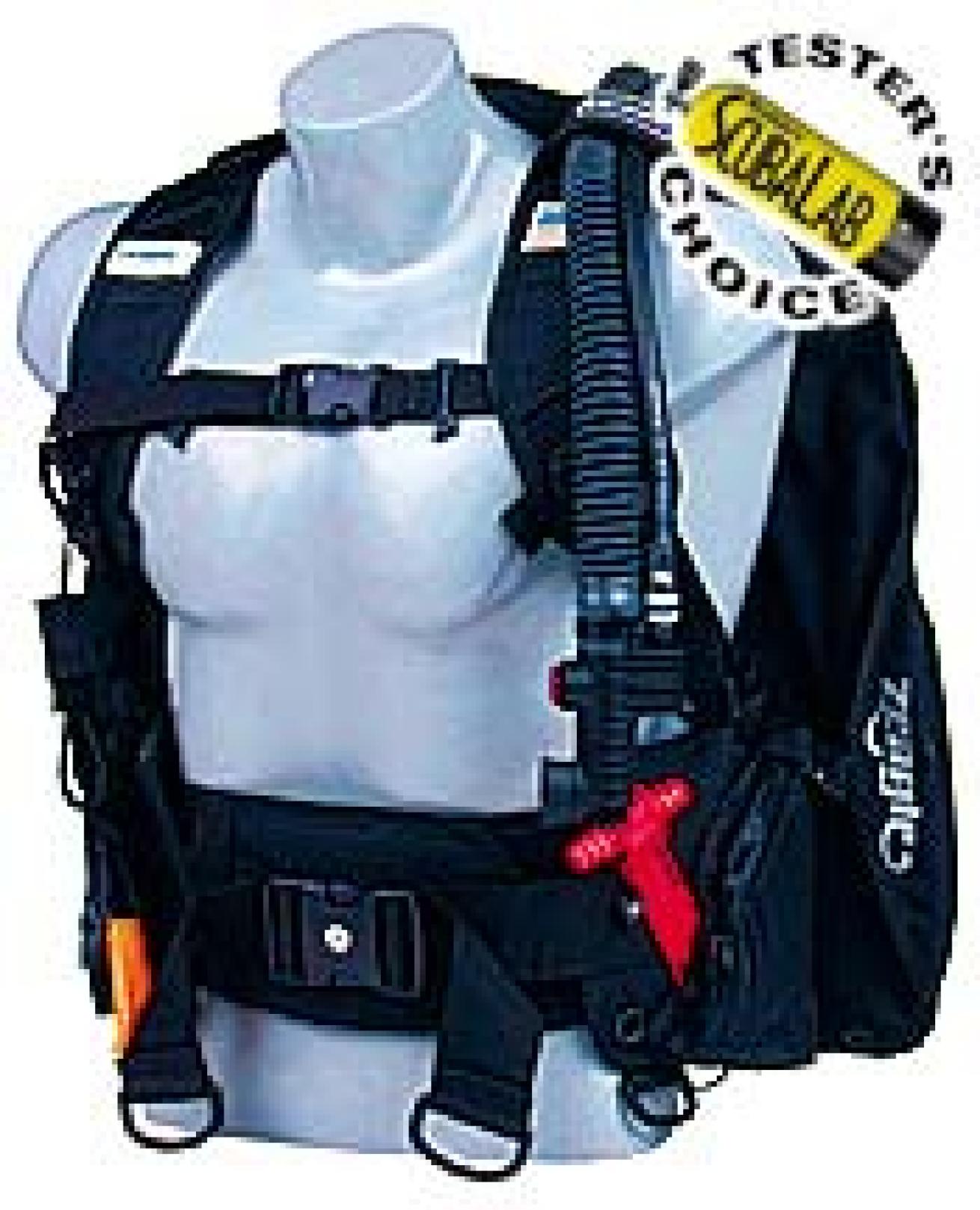
| | Zeagle Concept II Pro| The Concept Pro II, a Testers' Choice, is the beefy version of the Concept II series, with higher buoyant lift and more weight-carrying capacity. It's a modular BC: You select vest and shoulder components, then fit them to appropriate bladder sizes to get a BC customized to your individual diving needs. The result is a very comfortable BC with extra-wide shoulder straps, a depth-compensating cummerbund and substantial padding.
The Concept Pro II comes with Zeagle's patented "Ripcord" weight release system. The primary weight pouches are tied together with a threaded cord connected to a handle. With a single pull, all weights simultaneously ditch. It's by far the easiest method of ditching weights. The difficulty comes in re-threading the ripcord after the ditch. For that reason, it's better to use the zippered pouch openings to load and unload weights and use the Ripcord only for emergencies. Note: Avoid using small weights in this system. One, two and even three-pound soft weights can slip through the laced bottom of the ballast pockets.
Storage pockets are optional, but the Concept Pro II does come standard with double tank straps that control wobble and an elastic retractor system to rein in the air bladder. There are only four small plastic D-rings, and you can't access the rear remote exhaust valve without letting go of the ambient hose inflate/deflate valve. However, the inflator valve provides fine-tune adjustment and improves ascent control.
Price: $586.50.
Pockets with closures: None.
Sizes: Adjustable sizing.
Buoyant lift (claimed): 44 lbs.
Weight system: Ditchable, 40 lbs. front; 20 lbs. rear.
Backpack: Soft.
Tank bands: 2.
Pros: Ease of assembly. Good adjustment and fit. Efficient weight-ditch system. Good valve operation and ascent control. Negligible inherent buoyancy. Excellent weight ditching. Excellent owner's manual.
Cons: Slow pull dump. Difficult to re-arm weight system once activated. No pockets.
Zeagle Escape 7105 VK & RK: Good Performance, Good Price

| | Zeagle Escape 7105 VK| |
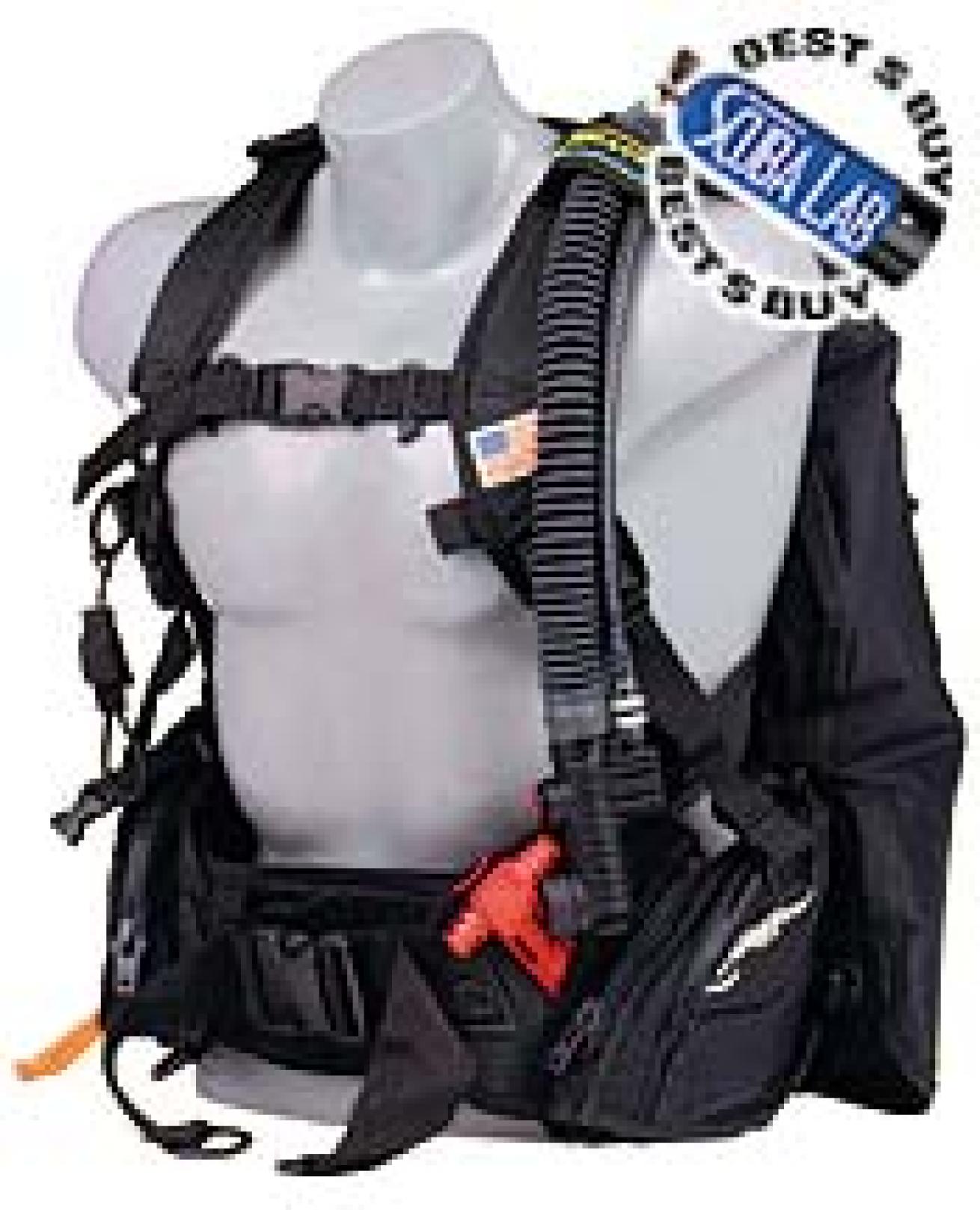
| | Zeagle Escape 7105 RK| Zeagle's Escape VK and RK, which are the same BC except for their weight systems and storage pockets, are both Best Buys thanks to good performance scores and a good price. The VK comes with conventional Velcro-flap weight pouches that load and ditch efficiently, and two Velcro storage pockets that are hard to access. The RK comes with the "Ripcord" weight-release system (see Concept Pro II), which ditches easily, and two zippered pockets that are hard to access and easy to confuse with the weight pouches.
Pockets and pouches aside, the Escape is a streamlined BC. It cinches up snug, leaving the chest area uncluttered. A depth-compensating cummerbund and thick lumbar padding provide comfort. The BC doesn't slip about, even in a heads-down position. A conventional band is used with a secondary upper strap to prevent tank wobble. The bladder is strung with an elastic retractor strap to control "winging."
In general, the Escape provides good inflation control; however, the pull dump doesn't seem able to keep up with the inflator on ascent (the ambient hose held overhead does). And the positioning of the rear remote exhaust on the lower left side is awkward.
Price: $479.
Pockets with closures: 2 Velcro (VK), 2 zippered (RK).
Sizes: Adjustable sizing.
Buoyant lift (claimed): 35 lbs.
Weight system: Ditchable, 20 lbs. front, 20 lbs. rear (VK); 30 pounds front, 20 pounds rear (RK).
Backpack: Soft.
Tank bands: 2.
Pros: Good assembly, fit and adjustment. Stable at depth. Good valve operation and ascent control. Good weight system (VK); excellent weight-ditch system (RK). Excellent owner's manual.
Cons: Slow pull dump. Storage pockets easily confused with weight pockets (RK). Difficult to re-arm weight system once activated (RK).
Zeagle Ranger: Rugged Recreational System
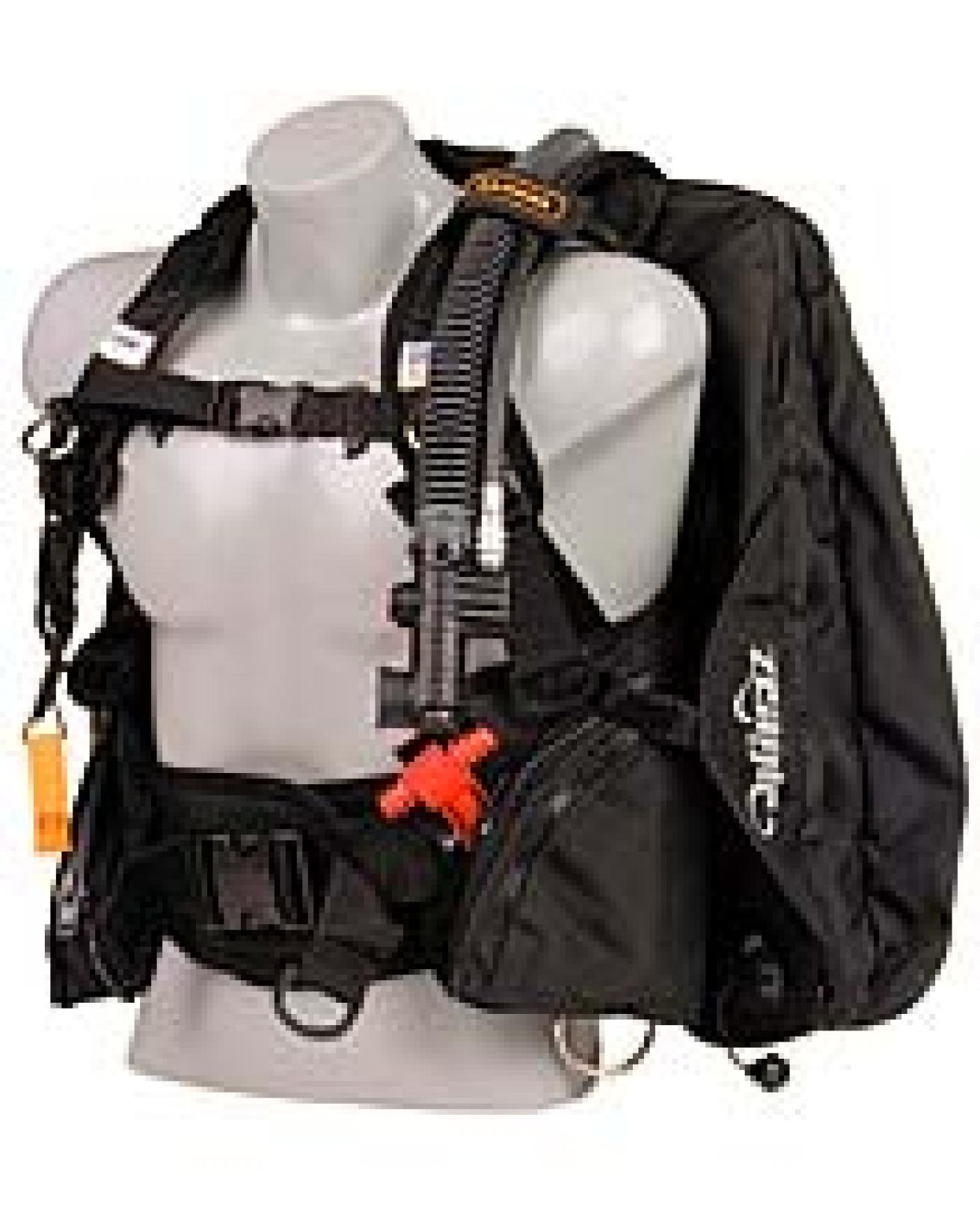
| | Zeagle Ranger| Marketed for divers who want "a rugged recreational system," the Zeagle Ranger is a heavy-duty, yet very comfortable BC that comes standard with a 44-pound-lift-capacity bladder. For those divers looking to get down to some serious business, there are 65-pound and larger lift capacity bladders available as options.
The Ranger is designed with adjustable elastic waist panels and a depth-compensating cummerbund for fit. Padding is minimal. A crotch strap is optional. Wing clips hold the air cell in closer for better streamlining at depth. Equipped with six stainless-steel D-rings, the two on the upper shoulders are adjustable. There are two zippered pockets that are easy to get to; problem is, they're positioned right on top of the weight pockets so it's easy to get them confused. The Ranger is twin-tank compatible.
The inflator valve fits comfortably in the hand and allows for fine-tuning buoyancy. The ambient hose held high produces very good deflation rates, but the pull dump is slow. Two rear remote exhaust valves dump air efficiently. Variance between claimed and measured buoyant lift is less than 15 percent.
The Ranger comes standard with Zeagle's patented "Ripcord" weight release system (see Concept Pro II). A removable Zipper Rear Mounted Weight System and a pull-out weight system like that used on the Escape VK are both available as options.
Price: $661.50.
Pockets with closures: 2 zippered, 1 Velcro.
Sizes: Adjustable sizing.
Buoyant lift (claimed): 44 lbs.
Weight system: Ditchable, 40 lbs. max., 20 lbs. rear (optional).
Backpack: Soft.
Tank bands: 2.
Pros: Ease of assembly. Good fit and adjustment. Stability at depth. Good valve operation, ascent control. Efficient weight-ditch system. Excellent owner's manual.
Cons: Slow pull dump. Marked inherent buoyancy. Storage pockets easily confused with weight pockets. Difficult to re-arm ditch system once activated.
Zeagle Scout: Unstable When Loaded
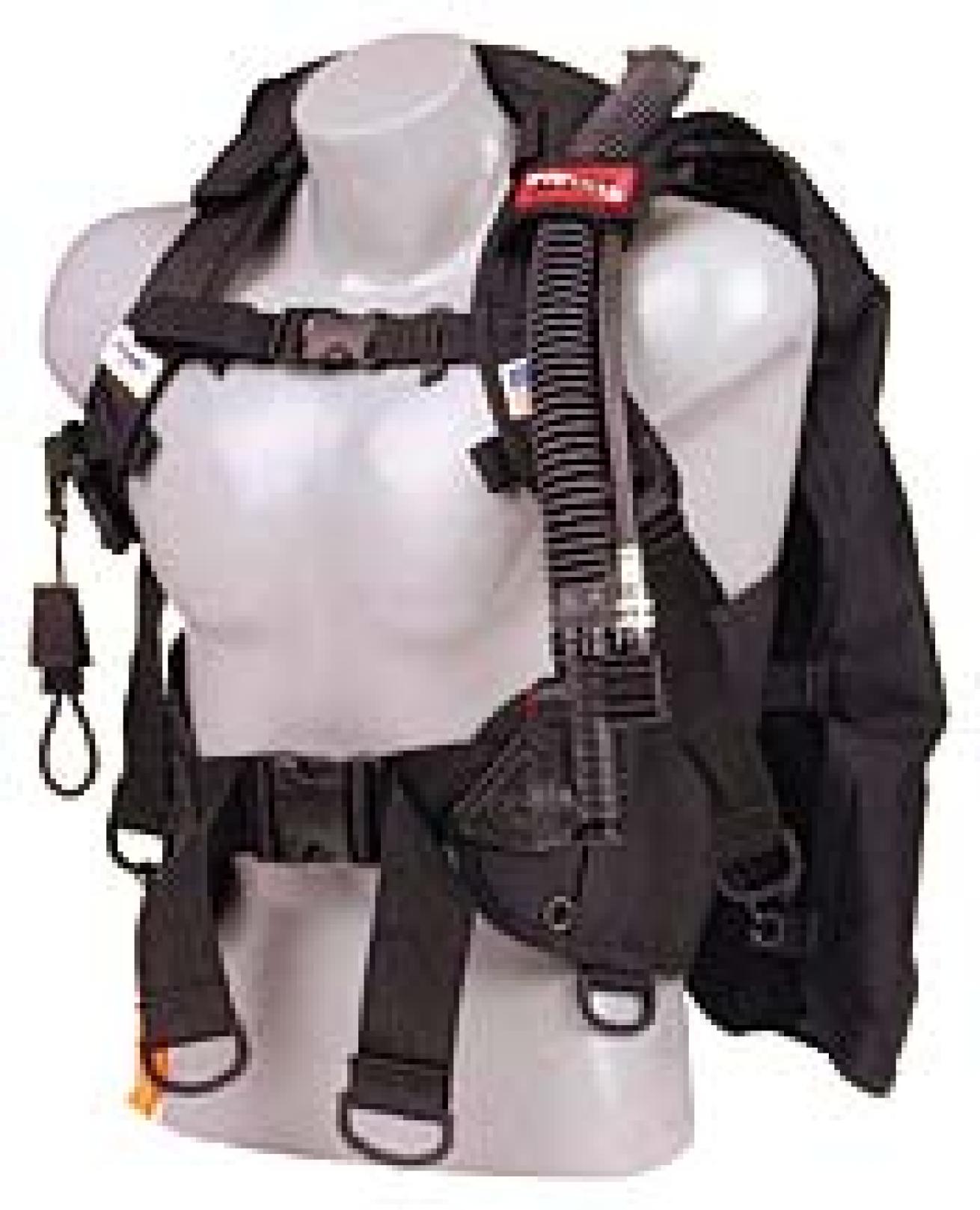
| | Zeagle Scout| The Scout is a simple, uncluttered weight-integrated BC with ballast pouches positioned alongside the tank (weights are ditched by reaching back and yanking on the lower flaps of the pouches). Available with either a 24- or 35-pound-lift air cell, the smaller cell is intended for smaller divers or warmer waters, while the larger cell is designed for divers who need to carry more ballast.
The problem is that the weight pockets are designed to hold up to 30 pounds positioned behind you. When they're loaded with more than a minimal amount of weight, the BC wants to turn you onto your back when in the swimming attitude, and flip you backwards when positioned heads-up. If you're going to use this BC in temperate waters, you'd be better off putting your ballast weight on a belt and using the weight pouches for trim only.
Otherwise, the Scout is a comfortable BC with a thick lumbar pad, wide shoulder straps and a waist strap instead of a cummerbund. The primary tank band and secondary tank strap are both vertically adjustable. The wings of the air cell have an elastic system to keep them from flopping about. Pockets are available as an option.
The inflator valve enables you to fine-tune your air flow, and the ambient hose dumps air well. But like other Zeagle BCs, the pull dump isn't very efficient and won't always keep ahead of the inflator in the wide-open position.
Price: $350.
Pockets with closures: None.
Sizes: Adjustable sizing.
Buoyant lift (claimed): 35 lbs.
Weight system: Ditchable, 30 lbs. max.
Backpack: Soft.
Tank bands: 2.
Pros: Ease of assembly, and good fit and adjustment. Negligible inherent buoyancy. Good valve control. Excellent owner's manual.
Cons: Weight-ditch tabs hard to reach. Unstable at depth.


